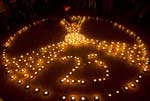Asia
Asia nuclear reactors face tsunami risk
Updated: 2011-04-19 10:30
(Agencies)
Experts hope Japan has taught the world an important lesson: When it comes to nuclear safety, it's essential to imagine the unimaginable. Looking back 50 years, or even 500, is not enough.
"When you're talking about radioactivity and possibilities of explosions ... you have to look at what is within the realm of possibility," said Jody Bourgeois, a tsunami expert at the University of Washington who was doing research in Japan when the disaster struck. "You should be building it with factors of safety for the maximum possible events."
It's not the first time a tsunami has threatened nuclear reactors.
The 2004 earthquake off Indonesia's subduction fault spawned the monster tsunami that killed 230,000 people in a dozen nations.
It also sent waves slamming into a nuclear plant in the southern Indian township of Kalpakkam, the country's center of atomic research, nearly a thousand miles from the quake's epicenter.
Though the reactors automatically shut down and no radioactive material was released, it showed that even facilities far from dangerous faults need to prepare for the worst.
While the near miss in India raised awareness, it did not prompt major changes to the safety design at the Madras Atomic Power Station, said its director, K. Ramamurthy. Last week, however, a top government official said India would revamp the safety features at all its nuclear plants to try to prevent a Japan-style crisis.
The Madras plant is among the scores that have yet to ask the IAEA for an independent review to determine if their tsunami preparedness assessments meet international standards.
The same holds for Pakistan, which built a plant along a coastline near Karachi that was hit by a tsunami in 1945.
Though the reports aren't mandatory, Antonio Godoy, the IAEA's recently retired top seismic safety expert, said many countries have held up efforts to build a comprehensive database identifying the plants vulnerable to tsunamis based on such reviews.
The Fukushima crisis does seem to have jolted some governments into action.
Tsunami expert Tso-Ren Wu of Taiwan's National Central University warns that "we are long overdue" for a similar quake on the Manila Trench. He was recently commissioned by Taiwan to model worst-case scenarios for all three of the island's nuclear plants and a fourth under construction. His findings will be used to help redesign the facilities or raise their seawalls, if necessary.
His studies indicate two plates that form the subduction zone are pushing against each other at a relatively fast 8.7 centimeters (3.4 inches) per year, forcing extreme amounts of energy to build up. A fault slip from the two plates would be up to 38 meters, comparable to what occurred during the 1960 magnitude-9.5 Chile earthquake, the largest on record. By comparison, the slips in Indonesia and Japan were estimated at around 20 meters. The greater the slip, the more water is heaved up to create bigger tsunami waves.
"What happened in Japan was not a surprise," said Godoy, who remains an IAEA consultant and has spent much of the past 20 years warning governments to prepare for worst-case scenarios. "Maybe now they'll wake up, listen and act."
E-paper

Han me downs
Traditional 3,000-year-old clothes are making a comeback.
Preview of the coming issue
Reaching out
Fast growth fuels rise in super rich
Specials

25 years after Chernobyl
Belarus, Ukraine and Russia will mark the 25th anniversary of the nuclear reactor explosion in Chernobyl.

Luxury car show
The world's most prestigious luxury, sports cars and supercars are displayed in Monaco.

Peking Opera revival
Traditional opera is enjoying a revival in Beijing thanks to some modern touches.
